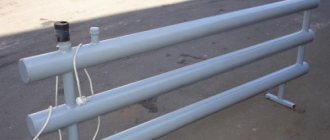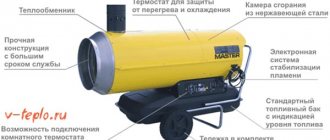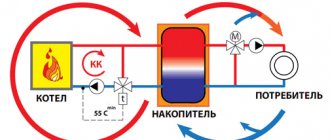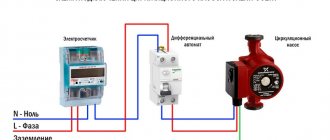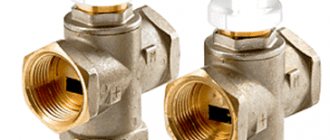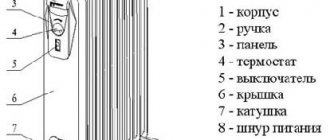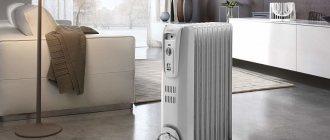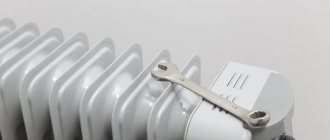Generally speaking, an oil radiator for 5-7 sections or other sizes of a household type is a sealed steel housing, which is filled with special oil, and an electric heater is installed inside the container, which is connected to a 220V AC network.
The principle of operation here is quite simple - the electric coil heats the oil with its heat, and it, in turn, transfers heat to the metal body and the heat transfer power of the heating device depends on the intensity of this interaction. We will talk in more detail about the design of an oil heater, its advantages and disadvantages below, and you can also watch the video in this article.
Oil radiator for 7 sections YL-A06-F-7 with fan
Oil heater device
To use the heater correctly and carefully, you need to understand at least the general principles of its design.
Oil heater design Oil heater design.
Oil heaters have been known to everyone since childhood. At one time, this was the most popular option for obtaining additional heat in a room. However, over the past decades, the situation has changed, and on the modern market there are various models of similar equipment with more complex designs and improved operational safety indicators. It is the simplicity of the design that causes a large number of counterfeits or simply low-quality devices on the modern market. It is much easier to manufacture such a device than other types of heaters.
If desired, even a schoolchild who understands physics can make an oil heater. Therefore, it is better to go to a store with a good reputation for such a device, rather than buy dubious imported equipment second-hand. In addition to this basic rule for choosing equipment, adhere to two more.
First, pay attention to the labeling of the device. It should not raise the slightest doubt
Some counterfeit manufacturers simply print out the logo of a famous brand and glue it to the box. Such markings immediately catch the eye and look very dubious.
Oil heater control panel.
Secondly, when studying the operating instructions for the device, pay attention to its service life, which is indicated there. As a rule, it is 5 or 7 years
Longer periods are less common. Be prepared to use the heater for this period and not a day longer.
Otherwise, the likelihood that it will explode increases significantly. You should not save on this equipment. This is fraught with large material losses in the event of a fire. A heater that has served you for its entire stated service life must be thrown away. Before doing this, it is recommended to damage it so that no one else has the opportunity to use the potentially dangerous device.
Radiator selection

In conclusion, let’s say a few words about how to choose the right oil heater so that it serves you faithfully for as long as possible. First of all, pay attention to the type of placement. Radiators can be hung on the wall, built into the floor, mobile, etc. Choose the modification that will fit most comfortably in your home.
Then pay attention to the type of case. It can be made in the form of panels or an accordion. The overall appearance of the device is no less important - choose the one that will fit most harmoniously into the interior.
Another selection criterion may be the type of heating element. But this is only relevant if you are going to repair the radiator yourself if necessary. The fact is that almost any repair work with an oil radiator involves draining the filler. That is, if the device, for example, has a leaky body that needs to be patched, then the first step is to remove the oil from it, and only then the necessary operations are performed. You can read how to do this in the article.
As a rule, all this is possible only if the tubular electric heater is presented in a removable form. Then it is easy to remove it and drain the oil through the resulting hole. If the heating element is rolled, then it will be impossible to remove it, for example, for replacement. And there will also be problems with removing the filler if special holes are not provided for draining in the radiator housing.
Selection rules
Choosing an oil heater is not easy due to the variety of models, which is more of a plus than a minus. In order not to make a mistake and purchase the most suitable model for a particular case, you should decide in advance on some parameters, the main one of which is the power of the oil heater in kW.
| The area of the room planned for heating, | Sufficient heater power, kW |
| 5–10 | 0,5–1 |
| 10–15 | 1–1,5 |
| 15–20 | 1,5–2 |
| 20–25 | 2–2,5 |
For independent calculations, it is enough to take the following information as a basis: 10 sq. m of area require about 1 kW of device power to heat, provided that the ceiling height is not higher than 2.75–3 m. The higher the power of the device, the more efficiently the room is heated, but at the same time the cost of electricity increases. The table above shows only the balance between the thermal effect and the lowest cost to achieve it. It is irrational to use an oil radiator to heat a larger area - sufficient heating does not occur, the air cools down before it reaches the far corners.
If you want to increase the heating speed (or the heated area), it is recommended to buy an oil heater with a fan - the circulating flow of warm air will quickly reach remote areas.
The next important parameter to choose is the number of sections in the radiator; the larger it is, the higher the heat transfer. For large rooms, more bulky models are suitable; for small rooms, several sections are enough.
Review of models. The products of Delonghi, which specializes in the production of household appliances, heaters and heating elements for them, are in demand. For example, the Delonghi Radia STRRS1225 oil radiator is suitable for heating large areas - up to 75 sq. m, equipped with a thermostat and a system that allows you to increase efficiency by 35%. This option is expensive - it costs 12 thousand rubles. The cheaper Delonghi GS770920, costing 3 thousand, has 9 sections and three power levels: anti-freeze function, normal and intensive heating.
You can buy a Luch oil flat heater for 1 thousand rubles; its power is only 0.5 W. SCARLETT products cost from 2.5 thousand rubles. SCARLETT SC-OH67B01-9 has 7 sections, power 2 kW and is designed to heat 20 sq. m.
The operating rules for oil heaters are described in the instructions for specific models:
- Do not disassemble the housing - oil leakage will lead to its ignition and fire;
- It is not recommended to dry things on the body;
- do not use the electrical appliance in wet rooms (bathroom or shower); for these purposes, special models are produced with built-in protection against wet vapors;
https://youtube.com/watch?v=VDV1iQfTqvY
WATCH THE VIDEO
An oil radiator has good performance characteristics, it is safe and reliable, so it is recommended to have such a heating device in your home or country house as an additional heating source. It serves for about 5 years.
Inclusion
The popularity of the oil heater is due not least to the ease of its operation. You don't need to frantically leaf through the instructions to understand how to install and run this device. The installation procedure in most cases is as simple as possible: you need to remove the radiator from the packaging, place it in the place intended for it, and then plug it into the network.
However, some attention should still be paid to the choice of location. As mentioned above, it is not recommended to place a device without a protective casing in a child’s room. There are two reasons for this. Firstly, children can get burned or drop the device, which is quite heavy.
Secondly, they can damage it. The metal from which the case is made is quite thin. It can be easily dented or punctured. Naturally, mineral oil will leak out - and it’s good if it cools down. Otherwise, there is a risk of the same serious burns. And the performance of the device, in any case, will be seriously impaired. You will have to either buy a new one or repair the broken one.
Also, do not place the device in the bathroom. High humidity levels are very bad for electrical appliances. When installing an oil heater in a room, make sure that there is no upholstered furniture, curtains or other interior elements near it that could catch fire. It is also impossible to place the device outdoors - that is, it is definitely not suitable for balconies.
However, among all these restrictions there is a pleasant moment. Most heaters are mobile. They are equipped with wheels that make it easy to move the device from room to room. Therefore, you may not be tied to a specific place.

Let's move on directly to the process of turning on the equipment. Typically the heater is equipped with two regulators. First, use one of them to set the power of the equipment. The maximum should be set only if you are confident in the reliability of your wiring. If you live, for example, in an old “Khrushchev” building, where major renovations have not been done for a very long time, then it is better to limit yourself to average power, since otherwise you risk later having to change sockets or wiring in general.
The second step is setting the required temperature. After this, press the power button located on the control panel and the heater will start working. If the device is equipped with a timer, then during switching on you can also set the frequency of operation of the device.
Many users have a question about how long they can leave the oil heater on. Often there are no restrictions at all. If they exist, they are necessarily indicated in the instructions for the specific model, so you should always read the accompanying documentation before starting operation.
However, there is one important point that applies to all radiators: if the device is not equipped with an overheating sensor, then it should only be used when there is an adult, awake person at home, who, in the event of force majeure, can quickly react and turn off the equipment.
That is, you do not need to leave such a heater on while you are away or sleeping. If the oil overheats, then, as mentioned above, the housing may become leaky, and this is fraught not only with equipment breakdown, but also with a fire. If the device is equipped with an overheating sensor, and also, preferably, a timer, then there are no problems - if a problem occurs, the heating device will automatically stop working. However, here you should take into account the original quality of the radiator - it is still better not to rely recklessly on models from the lowest price segment.
Design and operating principle
The design of the oil cooler is quite simple. It consists of a housing filled with oil and one or more heating elements. The heater is controlled by the existing regulator. It allows you not only to turn the device on or off, but also to regulate the intensity of work. Modern models of oil heaters can be additionally equipped with:
- fan;
- timer;
- remote control.
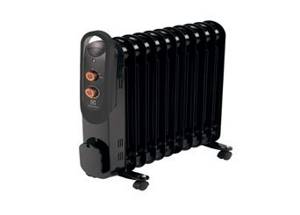
Read more about inverter heaters here.
The operating principle of an oil heater is as follows: heating elements immersed in oil heat up, resulting in an increase in the temperature of the filler, which transfers heat through the body to the room. Due to the fact that the cooling of heating elements in oil occurs quite quickly, oil heaters have high efficiency. Many modern models of oil heaters are equipped with built-in fans. With their help, a faster heating rate of the room is ensured.
Oil radiators are quite reliable, but they can still break down. There are different types of breakdowns, but one of the most common is an oil leak. In the event of such a malfunction, it is necessary not only to eliminate the leak, but also to add oil to the heater.
Popular models
The stores offer a large selection of oil heaters. Some are very economical, inexpensive, and have simple controls. Other models have a large number of additional functions, electronic thermostats and the like.
Modern designs are usually equipped with a handle on the body, with which you can easily transport the radiator from one place to another. A special casing that will protect against contact with the hot surface of the heater would be useful. This is very important for families with small children. There are models that have devices for drying clothes. It is prohibited to place wet clothes on the radiator itself. But this can be done with special holders.
There are heaters equipped with fans for better air heating and humidifiers. Some people prefer heaters with a fireplace effect. There are several models that are most popular among the population:
- Timberk TOR 21.1507 BC/BCL . This is an inexpensive device from a Chinese manufacturer with a power of 1.5 kilowatts. It heats up quickly, is easy to maintain, and has a mechanical thermostat. Perfect for both apartments and cottages.
- Royal Clima ROR-C7−1500M . This Italian heater has 7 sections. It has three operating modes: 0.6, 0.9 and 1.5 kilowatts. Has a fireplace effect. Mechanical temperature control.
- Unit Ur-940 . A simple but quite reliable radiator. Power reaches 2 kilowatts. The regulator is mechanical. Has 9 sections.
- ZANUSSI Nuovo ZOH/NV-11G . The device is Swedish-Chinese. Capable of heating rooms up to 28 square meters. Has a good protection system. Works in three modes.
- General Climate NY23LA . The heater is suitable for rooms of 20 m². Protected from freezing, operates in three modes: 1, 1.3 and 2.3 kilowatts.
Oil heater pros and cons
Which heater model is better can be decided only after analyzing the characteristics, prices and correlating the information with your own needs. Over the years of existence of oil types of heaters, they have earned a good reputation due to a number of advantages:
Electric household oil heaters have their drawbacks, which is why they have not become universal heaters in houses and apartments. Among the disadvantages of the devices are the following:
- the inertia of the radiator - it takes a long time to heat up: first the oil, then the metal body, and only after that the air in the room is warmed up. Therefore, if the task is to quickly warm up the room, you will have to look for another type of heating device;
- An oil heating radiator has a lower efficiency than other types, for example, convectors or IR emitters. The device spends a lot of energy on heating itself, so efficiency is 20–25% lower;
- The “considerable” weight and volume of the device makes the electric oil heater bulky and inconvenient for moving from one room to another, despite being equipped with rollers. It takes up a lot of space in the room, especially if the number of sections is 8–10;
- Clicks and noise effects when heating, occurring due to the movement of oil and expansion of the metal, cause inconvenience.
Despite these disadvantages, the device's rating among consumers remains high. An oil heater costs an average of 2,500 rubles.
Temperature adjustment
When the required temperature is reached in the room, slowly turn the thermostat knob back until the warning light goes off. After this, leave the thermostat in this position. As soon as the temperature in the room drops below the set temperature, the device will automatically turn on and work until the room temperature is reached. Thus, the radiator maintains a constant temperature in the room, while consuming a minimum amount of electricity.
Technical parameters of the oil device
During operation, some important requirements must be observed. The device must be stable and the cord must not be strained. Install in a place out of the reach of children or secure it. Avoid exposure to moisture. Do not operate near flammable materials. Do not use after the service life has expired.
Compliance with these rules will allow this useful device to work for a long time and bring joy to its owners.
If your heater explodes, you are most likely responsible. Although an oil heater cannot be called the safest option for the home, the likelihood of it exploding is low if you follow all the basic operating rules and adhere to safety precautions. Troubles that can happen with an oil heater are leaks, stoppages and explosions, which can lead to a fire, cause damage to your property, health, or threaten your life and the lives of your loved ones.
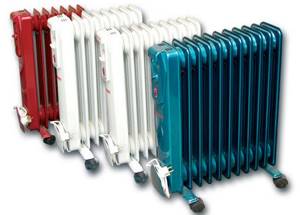
Oil heaters are silent and more efficient at heating, but their surface becomes very hot.
It is also worth considering the fact that not only a cheap Chinese device, but also a product from well-known manufacturers can explode. Therefore, the most important rule to avoid an oil explosion is: choose heaters carefully and responsibly.
Advantages
- Fire safety. Due to the low heating temperature of the body (maximum 110°C), oil-based household heaters are considered safer heating devices compared to other electric heaters. In addition, modern models are equipped with a horizontal installation sensor, which turns off the heater if the device is installed at an angle. This also reduces the likelihood of a fire.
- Quiet operation. Sometimes a quiet crackling sound appears while the oil is heating up. However, after the oil has warmed up to operating temperature, the sounds stop.
- They do not dry out the air and do not absorb oxygen. This is largely why they are so often used for additional heating in bedrooms. This is their main advantage over fan heaters, which greatly dry the air.
- Mobility. The device is equipped with 4 wheels, so even a pregnant woman can easily move it around the room.
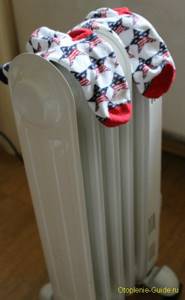
The heater is often used as a dryer.
Operating rules
After the leak in the oil cooler body has been repaired and the oil has been filled, special attention should be paid to the rules for its operation.
When operating heaters, you should adhere to the following rules:
- heaters should not be used in rooms with high humidity, for example, in a bathroom;
- the device must always be in an upright position;
- Do not use an extension cord when connecting, as it may overheat during operation;
- The oil heater should not be stored in a shed or on the balcony, otherwise it may quickly fail;
- The heater from various fusible products should be located at a distance of at least 50 cm.
Read more about infrared heaters here.
By complying with all the requirements listed above, you can be sure that the oil heater will last for a long time.
Changing the oil in an oil heater is not a very complicated procedure that you can do yourself. To do this, you just need to follow the recommendations. By doing everything correctly, you can extend the life of this heating device.
Due to interruptions in heating, the temperature in the living space may drop. To raise it, all kinds of heaters are used, including oil heaters with a fairly high efficiency. The latter has a number of advantages, since the operating principle of an oil heater can leave air humidity almost unchanged. The industry produces a wide variety of heaters; they have different characteristics, capabilities and design features. Once you get to know them better, you can choose the right one for your specific living space.
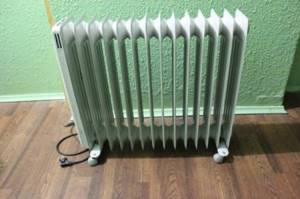
Oil fired heater
Types of radiators
There are no big differences between different models of heaters; they all have the same operating principle. However, there are several points that distinguish one device from another:
- power;
- profile;
- installation location;
- type of metal used in production.
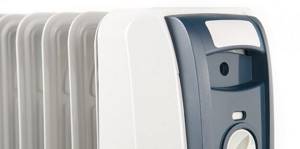
The first indicator indicates exactly what area, taking into account the height of the ceilings, the device can effectively heat. The power of models can range from 500 watts to 3 kilowatts. Radiators can be divided into three classes:
- low power;
- average;
- high.
Radiators from the first and second groups are actively used in everyday life. The minimum power ranges from 0.5 to 1 kilowatt. The average ones have a higher figure: from 1 to 2.5 kilowatts. With the help of such heaters you can make the air in the kitchen, bedroom, living room, and country house warmer.
High-power units (2.5-3 kilowatts) are used less often because they consume too much electricity, but the heat transfer from them is insufficient.
Sometimes it is more profitable to use two small radiators of 1.5 kilowatts as a heater than one large one.
Differences in panel shape
Heater profiles can be flat or ribbed. Flat models are usually not able to heat large rooms; they have low power. They are more suitable as an additional heating method. But they have their advantages: they are very economical, they can be attached to walls. The device consists of two plates that are fastened together. There are small depressions on their surface.
Ribbed models are more common. Externally, they are very similar to conventional steam heating batteries. Sections are made of sheet steel using laser cutting and spot welding; This technology ensures their tightness. The sections are interconnected. The batteries are coated with special powder paints, which, after the device has been in the oven, become resistant and give it a more attractive appearance.
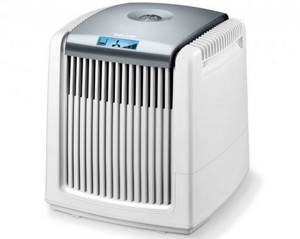
Heaters also have different shapes.
Ribbed models are good because they transfer heat to the air better due to the large area of the sections. But they are more difficult to use, they are not so easy to move or install anywhere other than the floor.
Location options
Oil heaters for the home can be either floor-standing or wall-mounted using special brackets. The location of the device depends on the specific model. Floor-standing radiators are more powerful and heavier, they are equipped with either legs for stability or wheels to improve the mobility of the device. Both ribbed and flat heaters can be installed on the floor.
Wall-mounted models are more expensive than floor-mounted ones due to the complexity of their installation, fire safety requirements and appearance. These are, as a rule, flat heaters, one side of which has a special screen to protect the wall from high temperatures.
There are universal radiators, also flat. They can be installed on the floor, for which wheels are included, or on the wall using brackets. In the second case, you should take care of thermal insulation, for which materials covered with foil are used.
Materials used
The power and weight of the radiator depend on what metal is chosen for the production of the radiator. Commonly used:
- steel;
- aluminum;
- their combination.
Powerful heaters are made from steel. They are heavy and can be damaged if dropped. Ribbed steel structures are used to heat large rooms. They are durable and give off heat well. As a rule, low-power flat heaters are made from aluminum.
Combined or bimetallic models combine the advantages of both metals. The internal structure is assembled from steel, which makes the device stronger.
And the top aluminum layer ensures optimal air heating. When you start working or turn off the combined models, you can hear a specific crackling noise. This is because steel and aluminum have different expansion coefficients.
Oil cooler design
The heater device consists of mechanical and electrical parts. The main and largest element is the metal container in which the mineral oil is located. Based on the appearance of these tanks, the heaters are divided into:
Panel ones have a flat shape without cutouts and can be installed both on the floor and on the wall. To do this, the manufacturer can supply the device with special fastening devices. Compared to sectional ones, to obtain the same power, panel ones are made in larger sizes. Sectional ones consist of segments of the same type assembled into one structure. They are designed for installation on a vertical surface. The more sections a heater contains, the more heat it can produce and therefore more power.
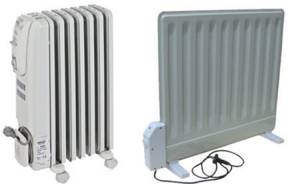
Types of radiators
The tank may be equipped with a safety valve; it protects the container from dangerous pressure. A tubular electric heater (TEH) is mounted at the bottom of the tank; it heats the oil to the required temperature. In addition to the heating element, the circuit includes the following elements:
- fuse;
- thermostats;
- warning lamp;
- power switch;
- fan;
- rollover protection.
All electrical elements, except the heater, are located on the cover. The fuse makes the electrical circuit safe by protecting it from short circuits and is located near the input of the power cord. An LED is used to signal the operation of the device; there may be several of them, depending on the additional purpose. The power switch is presented in the form of a toggle switch when using manual control, or a variable thermostat in an automatic device.
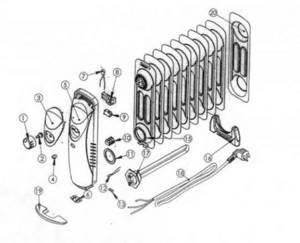
Heater device
Temperature control is carried out using a thermostat. How is it built? This device consists of a bimetallic strip and contacts. The plate is assembled from two metals having different expansion coefficients. When heated, one part of the plate expands more than the other, and the strip becomes deformed. This property is used for switching contacts of electrical devices; when heated, the plate bends and presses on the insulating support of the contact, disconnecting it. When it cools, it returns to its previous position, connecting the contact.
If such a plate is moved away from the contact, then operation will occur at a higher temperature. The plate is heated from the tank itself, since the thermostat is located in close proximity to it, and from external air through the housing on which it is located.
In some devices, manufacturers install a fan, which increases heat transfer, which leads to increased speed and uniform heating of the room. An important device is rollover protection. It consists of two contacts, one fixed, the other movable, located on an eccentric plate.
Parameters to consider when choosing
Depending on the purpose for which the heater is purchased, the requirements for the device will differ. Therefore, before going to the store, you should think about how long this unit will be used, how much space it should heat, where it will stand, and so on. Sometimes even the color of the case matters. Other features to consider when purchasing can be seen in this video:
For ease of movement, some structures are equipped with handles, this makes it possible to easily move them, for example, from one floor to another. If you need to first heat one room, then another, then the built-in rollers will come in handy.
They won't scratch the floor and only require one person to move, even if the unit is hot. In cases where there are few outlets in the house, a long cord is required, this is also provided by some manufacturers. If the cable is not completely used, its remains are wound on a special bracket. What else should you pay attention to?
Power
This is the main indicator; the time spent heating the room depends on the power. A lack of power will not allow you to raise the temperature to the required value, and an excess will not be considered a disadvantage, unless heating occurs faster and the price is higher. Another thing is that more powerful heaters consume more current per unit of time. This can be seen in the table below.

Dependence of current on power
If you add an electric kettle, a powerful vacuum cleaner, or a water heater to the heater, the home electrical system will fail. Another reason to choose a less powerful unit is to reduce humidity. The more powerful the device, the drier the air becomes.
Advice. It is usually recommended to choose power at the rate of 1 kW per 10 square meters, provided that the room is insulated. If there are cracks in the doors and windows, then a powerful device will not cope, especially if there is severe frost or wind. For a more accurate calculation, you can use the electronic version of the power calculator.
Radiator section thickness
Manufacturers try to make the thickness of the sections as small as possible, because the oil cools faster. Unlike water radiators, which use process water with many impurities deposited in them, oil radiators use pure coolant. To increase heat transfer, in some models the upper part of the heater is expanded, as can be clearly seen in the figure.

Extended top model
Others incorporate a fan, forcing air through the sections.
Power mode switch
This function allows you to adjust the heating speed. Mainly used to quickly heat a room. For example, arriving at a dacha or country house for weekends or holidays. Two types of switching are used:
- using switches;
- using a thermostat.
The first method uses additional heating element coils. Turning on all the switches located on the case puts the device into forced mode. After the temperature has reached the desired level, the additional heater coils are turned off, and the device operates in gentle conditions.
In the second case, a wire with increased resistance is wound onto a bimetallic plate through an insulator and connected to the heater circuit. During operation of the heating element, the wire heats up and heats the plate. The more the spiral works, the more the plate heats up; when the set level is reached, it is triggered, turning off the spiral. Usually there is a second indicator that signals when the device is turned on and off.
Humidifier
Rapid heating of the room is associated with one unpleasant consequence - the air becomes dry. This occurs due to an increase in its volume. When heated, the gas expands and the excess goes outside, causing the water vapor content to decrease and the air to become dry. This phenomenon is poorly tolerated by many people. Some heater models are equipped with an air humidifier. This is a plastic water container that is installed on the radiator. While the heater is operating, the container heats up and the water begins to evaporate, saturating the air with the necessary moisture.
Interesting! To raise the humidity, just hang a damp cloth next to the device. When it dries, the water passes into the surrounding air. Wet cartridges can also be used; they are installed in the path of the fan, which drives air through the radiator.
Built-in fan
The main purpose of the fan is to speed up heating. It is mounted in the cover in such a way that the air flow created by the fan is directed towards the radiator. Passing through the heat exchanger, the air heats up and, leaving the unit, mixes with the surrounding atmosphere. Turns on and off using a switch located on the lid. Thanks to forced circulation, air mixing occurs faster. Typically, fans are installed on more powerful devices.
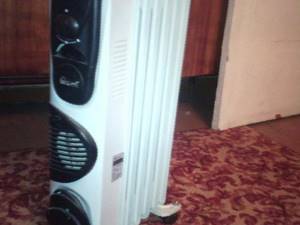
Heater with fan
The disadvantages are noise and the need to control the condition of the fan, because... it is not designed for long-term operation.
Device weight
When choosing, do not forget about the weight of the device. If it needs to be carried and transported frequently, then it is best to choose one with handles and wheels. Weight will depend on the power of the heater and the presence or absence of a fan. The number of sections and the size of the device itself also affects the weight. Therefore, you should consider all the pros and cons, and, if everything suits you, make the final choice.
Principle of operation
A heating element for an oil heater with a power of 1–2.5 kW is used as a heating element. The heating element is a spiral heated by electricity and sealed in a tube - hence its name, which stands for tubular electric heater. It is placed in an oily viscous liquid, which is enclosed in a metal body that is resistant to aggressive chemical environments. Connected to a 220 W network, the heating element first heats itself, then the temperature of the oil increases, and from it the metal body. Modern models are equipped with useful devices that perform additional functions:
- The thermostat for the oil cooler prevents overheating,
- the fan increases the speed of heat distribution throughout the room;
- A thermostat for an oil heater helps you set one of several possible modes.
Oil-filled heater operation
The operating principle of the oil cooler is as follows. When the device is connected to the electrical network, the device goes into standby mode. To turn it on, you need to select an operating mode; it is selected using an adjustable thermostat.
Other models on the case have two power adjustment keys; when one of them is turned on, the following circuit is connected: power is supplied to the fuse, then the current passes through the heater spiral, indicator light and mode switch contacts. After this, it passes through the closed tip-over protection contacts; if the heater is tilted strongly, these contacts are open and the device will not turn on. Then the current passes through the contacts of the emergency and adjustable thermostat and goes into the network. If you need to increase the heating speed, turn on the second heater coil using another key, which is connected in parallel to the first.
How do thermostats work? As the heating element heats up, the oil around it also begins to heat up and rise, and cold oil comes in its place. This is how the entire volume of coolant is mixed and heated.
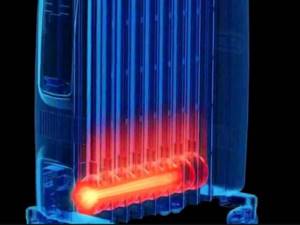
Action of heating element
Heat is transferred to the walls of the radiator and then to the surrounding air. The thermostats located in the lid begin to heat up. When the set temperature is reached, the thermostat operates and disconnects the circuit. After the thermocouple has cooled, the contacts close and the heating process continues. For clarity, you can watch this video:
Important! There are ventilated holes on the lid; if you close them, the thermostat will take a very long time to cool down, which will slow down the heating of the room.
The emergency thermostat protects against overheating; it is adjusted at the factory to the maximum temperature. If for any reason the service thermostat does not operate, the circuit will open the emergency device, preventing damage that could be caused to the heater.
It can be returned to its working position by pressing the corresponding button. This design allows the owner to find out if a malfunction has occurred; it must be eliminated before starting to use the device again. If there is no such button, the heater must have an emergency valve. De-energization will also occur if the electric heater is tipped over due to the activation of the tip-over protection.
Classification and main characteristics
There are many oil-type radiators, which differ in the number or presence of additional options - built-in mechanisms, fans or place of operation.
Wall mounted
Models that can be attached to a vertical surface are called wall-mounted. They tend to be flatter and have non-protruding sections that do not interfere with the bracket's ability to catch on the hanging hooks. Often such modifications are universal - they have a place for screwing on wheels, which allows you to install them on the floor in the right place.
Floor-standing
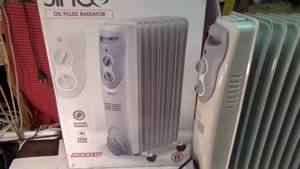
The heat transfer of such a floor-mounted device is the highest. There is a separate subtype of floor models - baseboard heaters. They are installed in the corner of the wall and floor in place of the baseboard. They have a long and narrow shape.
Tabletop
Modifications that can be placed on a table are small in size and the same weight. They are designed to provide additional heating to a small room. Also used in the form of heating a children's room or crib.
The number of sections for tabletop types is no more than 5; the height of such sections is half that of floor ones.
For cots
Radiators designed for heating children's rooms differ, in most cases, in their appearance and mobility.
These can be either wall or tabletop modifications with bright colors. A significant advantage of using such a heating element is that the air does not dry out, and the humidity during battery operation is at least 60%, which is important for children who are often ill.
Children who often suffer from acute respiratory viral infections or chronic lung diseases - bronchitis, laryngitis, tracheitis - need constant air humidification. Fans that operate on the principle of a hair dryer cannot be used to heat a room - they heat up and move air around the room.
